Extinction #4 - The Smilodon, Understanding The Saber Toothed Tiger and a tribute to the Conservation of the Cheetah
Am a good fan of games, mostly the action games though, they can ease the mind when needed, that's playing one so thrilling, do you play too, you might have came across the Far Cry Primal which takes us back to the Ice Age, the age of the huge megafunas which roamed the Earth , anyway that's my good reminder of the animals of the Ice age, amongst them was a megafuna, one having a magnificent view of its muscular body and the scary sight of its teeth, The Smilodon, A Sabar toothed Cat.
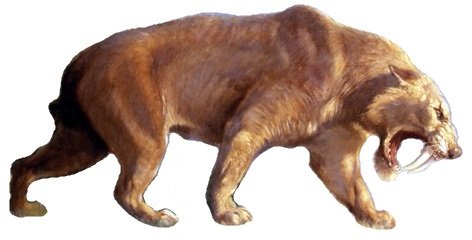
Wikimedia : Smilodon populator by Charles R. Knight, image available under CC BY-SA 3.0
Actually they were nicknamed the Saber toothed tiger, I know you would not mind the nickname as their huge body structure might just be saying "Am a Tiger" so I will refer to them as tigers every once in a while. The Smilodon is quite an animal to admire, they have their major trait to be their canine which is quite a length. Not until about 10,000 years ago, this apex predator was among the top of the food chain in the animal kingdom but got their numbers going on the negative with time till they were no more, now you might be wondering why this might have befallen such an animal.
In today's issue on EXTINCTION, we will go into the world of the Palaeontologist as we try to understand the world of the Smilodon, using their discovered fossil to analyze deducing informations on what surviving might have been like for them and Just like i always do on this series , I will also introduce a concerned member as we try to fight the war against the extinction of animals of the wild, welcome to Extinction #4.
A Discription Unseen
Trying to achieve what they might have looked like, their description was achieved by taking analysis of their fossil found, analysed and compared to other animals of the same genus. The Smilodon was noticed to actually range about the same size as the big cats but was different as it was noticed to have a short feet and short tail but most importantly, one thing which made them distinct was their canine teeth which you can see from the image to be quite long.
Of the saber-toothed cats the Smilodon had the longest of the canine teeth, the Smilodon was describe to have had three members in its subspecies and these members were noticed to vary in size with one of its members, the S. populator known to be the biggest.
With regards to the size of the S. Populator was the biggest followed by the S. Fatalis and lastly the S. gracilis, the S. gracilis weigh at the range of 55-100kg and it's size is approximately the size of a living jaguar, the S. fatalis which is the mid range specie has its weight to fall in the range of 160-280 kg and its height to be about 100cm it was about the same size as the lion but quite muscular than the living lion and lastly the biggest member which is the S. Populator got its range of weight to fall between 220 and 400 kg and analysis say it was quite a large mammal, even bigger than the Bengal tiger When comparison was made of their footprints.
There is actually no hint of how their body color might have looked like hence giving artist who tried to bring a natural view of this animal no clue of their body coloration but on trial to bring a view of the Smilodon in collaboration with some paleontologists, Charles R. Knight proposed drawings for the Smilodon which is now being used as a view of this Saber toothed cat, according to them, the Smilodon might have looked like a bulldog which attest to its ability to open its mouth to quite a wide range and having lower placed ear, this shape was a call for dispute as Mauricio Anton who was a Paleoartist likened it's view to be relative to other cats and his proposed view might someday be disputed too.
When the case of how it's coat might have looked like, it also called for confusion as they considered the possibility that this animal might be one without spots but on a rethink, they might just have spot they thought, this led to the art of this animal to be both of a spotted on and also one having a plain colour but according to general analysis of the cat species, it was discovered that those who have their habitat to be around the vegetative parts of the world are seen with markings than those who live in the open, however we can not still come to a conclusion as to how the body marking of the Smilodon might have been, I won't blame you if you came up with your diagram though.
Where They Might Have Lived
Information of where they might have occurred can be infered from where their fossils where found and after some case studies it was noticed that they might have occurred more through America. North America is known for its subtropical forest and to its South have the savannah which might just be a typical vegetation and climate loved by the Smilodon, mostly the s. fatalis was said to have occurred in this area.
The S. gracilis was said to have occurred around South America they faced less competition in their habitat and grew enough to give rise to the biggest species of the Smilodon, the S. pooulator which suggestion say might have occurred mostly in Eastern part of the earth.
In South America, the S. populator specie dominated, hunting the large of its habitat which was believed to have been dominated by animals such as the phorusrhacid also known as the terror bird, they had less competition in their habitat, the S. populator conquered it's habitat reaching quite a large size due to its unopposed diet of large preys this was suggested from evidence of their diet which was from Isotope ratio.
Developing Their Structure
To understand how the Smilodon develop, studies was taken of a juvenile and adolescent found in Rancho La Brea, this specimen led to the discovery that the Smilodon might have begun to get its long canine as they turn a year and half of age, initially they would have a baby teeth which will be shed later on, this might have taken about 11 months and additionally their jaw muscle might have also begun development at same time when they begin to loose their baby teeth.
Their long canine teeth begins to pop out after loosing their baby teeth seeing them growing at an average rate of 7mm in a month for the first twelve months period and getting fully develop at three years of age. After a study which was conducted in 2017 on a juvenile Smilodon it showed that a juvenile at birth possess a related body build with an adult and only develop in size with time.
The Preferred Hunt
On a quest to discover what the Saber toothed cats might have had for their meal, a research was conducted by some researchers who focused on the study of their tooth , studying their dentition, the pattern of ware on their teeth and with a process known as carbon dating compared theirs with other herbivores of their habitat, this led them to some discovery and hence making a list range of some animals which they might have preferred to hunt.
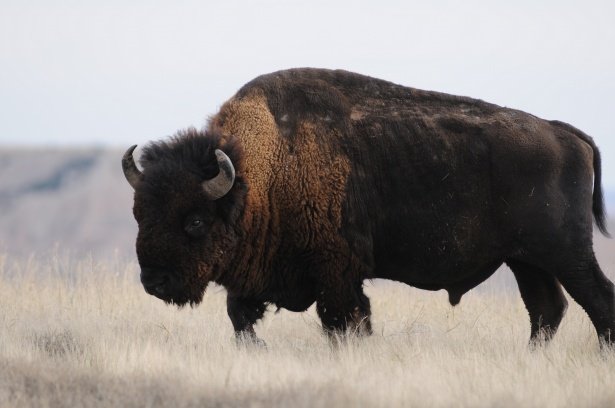 [The Bison might have been a preferred hunt. Source: publicdomainpictures, CCO]
[The Bison might have been a preferred hunt. Source: publicdomainpictures, CCO]
According to their discovery, the Saber toothed tiger might have been an animal with love for the big animals packed with flesh, as their dentition suggests, some animals which they might have hunted are the Antelope, the Mastodon which is an extinct elephant, the Bison, the American camels, the Antelope and the prong Oxen. They might have also went for other animals due to their predatory nature, some of these might include the mountain lion, the hyenas, the bear cats, jaguar and the grizzly bears.
With regards to relationship with humans, they might have had confrontations but this did not suggest they had humans as part of their meal, the Super hunter of the animal kingdom "man" was good enough at the defence from the big cats of the forest, they might actually have brought their numbers down.
Would you like to know how the hunt might have been like, let's see the Smilodon hunt.
The Saber Toothed Tiger At The Hunt
It's true they have this long canine which seems like it's might obstruct a bite during a hunt but this is just perfect for the strategy used by this animal to bring down its prey, unlike other cats such as the tiger which gives the kill by giving a big bite at the back of its neck with aim to server it's spinal cord the saber toothed cat takes the opposite which we will see in a bit, also it's relative the tiger starts the hunt by stalking the prey and mostly prefer the hunt in the dark.
Smilodon at the hunt sees the hunt to be a stalk and pounce one, using its teeth which is quite a weapon to give a bleed to death kind of kill to its prey, the Smilodon jaws are not built for the huge bite through spines like the tiger hence you will see them giving their prey the bite at the fleshy parts just like the abdomen and throat hence our prey begins to loose blood till death.
The Road To Extinction
Were we to go back in time, say about millions of years ago, we will see this megafuna, the Saber toothed tiger claiming it's lands as an apex predator, a body structure to be feared, but about 10,000 years ago towards the end of the last ice age this feared predator became extinct for some reasons. Now you would wonder, this is a strong animal with control of the forest, how can such ordeal fall on such an animal, in this section, I did a compilation of possible reasons for their extinction based on information from Palaeontologist after intense study of this animal.
A very common theory on the extinction of the animals of Pleistocene period of which the woolly mammoth, the saber toothed cat did not survive is the climatic factor, human competition and the lack of food, to get a strong edge in this they studied the teeth of this animal and other related specimens discovered dating back to the period of extinction, let's see how time might have happened to them.
During the end of the late ice age, there was an intense climate change which saw seasons of rainfall, rise in temperature and the melting of glaciers and ofcourse animals of this period should notice the change too. Though many animals survived this period due to adaptations, many could not survive and this consisted mainly of the megafunas of this age this might just be because of a major feature of this period that they could not do without but that's just one of the theories.
Another theory was that the lack of food or say less animals to hunt led to their demise, this theory was suggested due to the most preferred hunt of the saber toothed cat, the Bison which also were at reduction in that period, this theory was suggested after noticing ware pattern in the teeth of this animal which might suggest they tried to finish up their meals even as much as chomping the bones.
However after another study on recent discovered fossil the lack of food theory was countered, this was done by analyzing their tooth to that of an American lion with a method called the Dental Microwear Texture Analysis, it tries to produce an image of its teeth in 3D thus analysing the ware pattern of teeth suggesting and the outcome suggested that they might have engaged in some bone crushing during feeding which is an explanation for the worn teeth.
The last theory of this period is the human factor, which suggests that humans might have tested their hunting skill on them, that might not be far from the truth as humans are known to be good hunters, employing skills and tools which is just enough to bring down megafunas but it was another countered theory by many saying that humans though their advancement in that period, were not capable enough to lead to the demise of a specie.
And these ther the suggested theories, though non have a very strong backup for us to conclude a fact of the extinction of the saber toothed tiger, these are sometimes to give us a glimpse , the fact they are extinct will always leave us wondering and will be a reminder that even the biggest megafunas are capable of joining the extinct animal so we have in our power to fight against that in ways we can, on the tribute today as we always try to save a related specie, we have the cheetah which is known to be on the extinction road, let's get to know about the cheetah and how we can help.
A Concerned Cat, The Cheetah
Scientific Name: Acinonyx jubatus
Status: Endangered
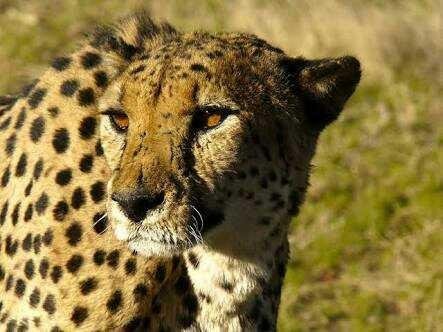 The Cheetah, Source : Flickr image by Martijn.Munneke
The Cheetah, Source : Flickr image by Martijn.Munneke
We all know the fastest known land animal, an animal built for the chase of which it's known maximum speed is measured to about 114 km per hour when they are on the hunt, their body is seen to be of a pale yellow colouration which is spotted with black almost all through, their body length is measures about 1.2 meters and as opposite to the saber toothed tiger, they are known for their long tail.
This animal which was known to have quite a number with regards to their population is now an animal of concern, an estimation of their population in Africa only got a number of about 9000-12000 and in Asia which was known to be their peak dense area see them to be nearly extinct there, their numbers today call for worries on their survival and this reduction in population is due to some threats to their population and as a tribute to them, we will see some of the threat faced and some proposed solution, only then can we work together to see to their continuation in our world.
Threats On The Cheetah And Proposed Solutions
The cheetah over the years have gone on reduction of its population due to some reasons which would be mentioned in this section of this article as we try to access ways to help the cheetah regain their numbers, bringing them from the vulnerable state of their population, these are threats and suggested solutions .
Loosing Their Habitat
After accessing the threat to the cheetah around Eastern parts of Africa, it was noticed that the major reason behind the decrease in their numbers is mainly due to the loss of their habitat being that they are a specie of animal which like their space and conservation areas are not big enough for their survival, this loss of space is mostly due to human activities in these areas encroaching into the areas occupied by the cheetah.
The landmass of the cheetah should be studied and these areas protected to prevent the activities of man encroaching in these areas, though the increasing population of man and the need for more landmass is always on the call, we should find a way to co-exist with these animals of the wild as they have a great role to play in the balance of the ecosystem.
Conflicts With Human
Humans have in one way or another led to the extinction of many species of animals, mostly killing them when they interfere with their activities, the cheetah is a known hunter and may sometimes attack the livestock of humans living close to its habitat, this force those living in the area to trap or kill them when they come around thus reducing their numbers.
The conflict between animals and man can be countered through community orientation on the need to conserve these animals, they are important to the ecosystem and hence should be conserved, if possible, rearing of livestock should be done in protected areas so as to avoid contact with the predatory animals of the wild.
The Lion Is Not A Good Friend
The food chain sees the lion to be higher than the cheetahs and hence nature sees the lion to hunt the cheetah for meal, this have caused a great blow to the cheetah, mostly the juvenile cheetah as according to statistics have seen their juvenile mortality rate to be increased to a percentage level of 95, with the Lions always attacking these juveniles, their numbers reduce by the day leaving less juveniles available for the continuation of this cat species.
As we do not have power in the control of the food chain, we can just try our best to keep check between the contact between these predators and a solution might be keeping them in conserved lands which meet there survival so as to keep them safe from dangers facing the Lions.
Illegal Treading And Captivity.
Cheetahs have been treaded illegally and also kept in captive which do not help their population in a positive way being that they are known to have a reduced rate of reproduction when kept in captive, illegal treading have also seen the treading of the cubs and skins of this animal and this is another major problem being faced by the cheetahs population.
Only when we increase our fight against these can we be able to make progress in stopping illegal treading and Captivity of this animal, laws have to be enforced and the general public engaged in the fight against this and hopefully we will restore the numbers of the cheetah.
Other ways to help these animals is by supporting groups who take it upon themselves to see to the survival of endangered animals either by donation or helping them in their outreach activities.
Bringing It All Together
The Smilodon is quite an animal and it would have been a great sight to behold if we were to have such an animal still in existence but it's unfortunate we can only paint them, even painting them with no clue of how their coat colour might have been, an imaginative painting , anyway let's make the diagram good. Below is a compiled video made on the extinction of the Saber toothed tiger for more information.
A compilation for the Saber toothed tiger, Source : YouTube
In the late ice age, many animals went extinct, this might most likely be due to the changes which occurred with regards to the climate as most animals were unable to adapt or probably that the extinction of others affected their predators causing them to lack prey, and even the actions of humans within this period, all these might have brought together the extinction of these animals and my point is that, any minute change which affect the population of an animal should be considered important as they can cause great blow with time, bringing me to our concerned animal for the day, the Cheetah, we should try in ways possible to support this animal with the hope of regaining back their numbers as the were years ago implementing conservation strategies for their survival.
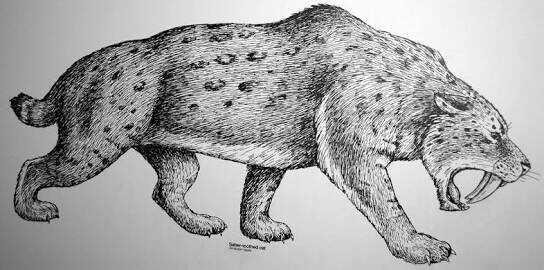
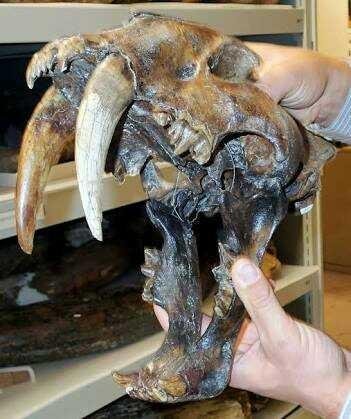
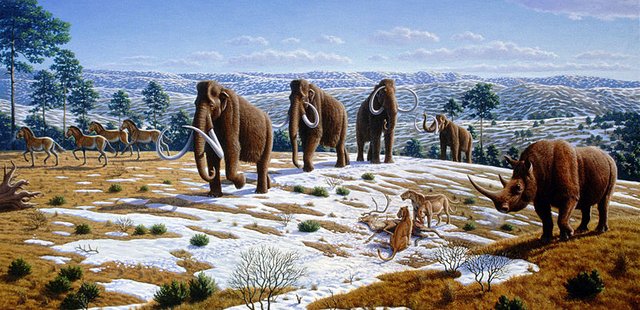
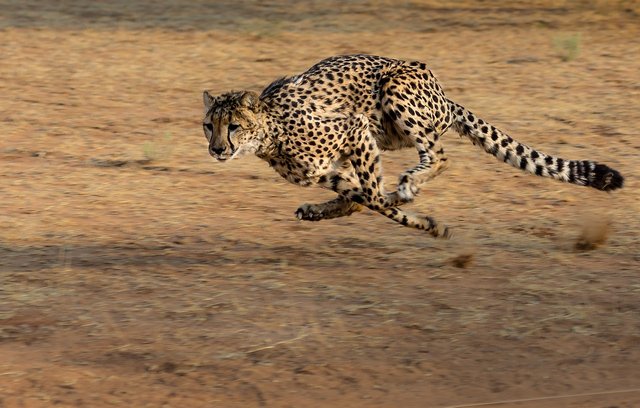
Congratulations @logic42! You received a personal award!
Click here to view your Board
Congratulations @logic42! You received a personal award!
You can view your badges on your Steem Board and compare to others on the Steem Ranking
Vote for @Steemitboard as a witness to get one more award and increased upvotes!